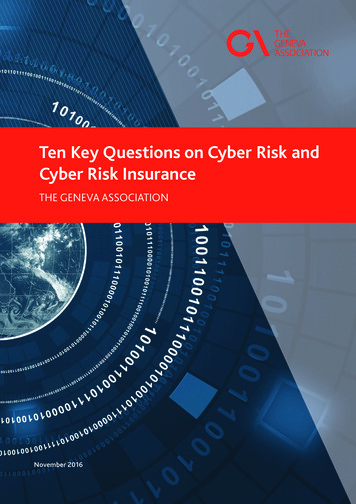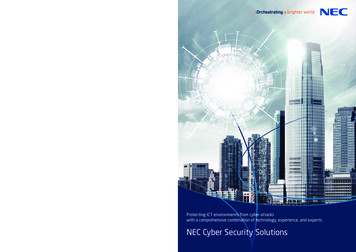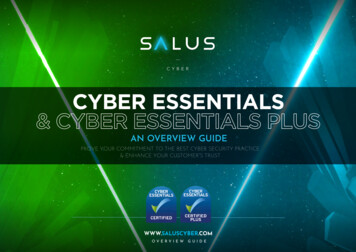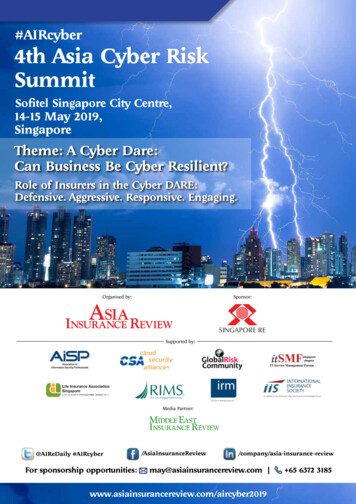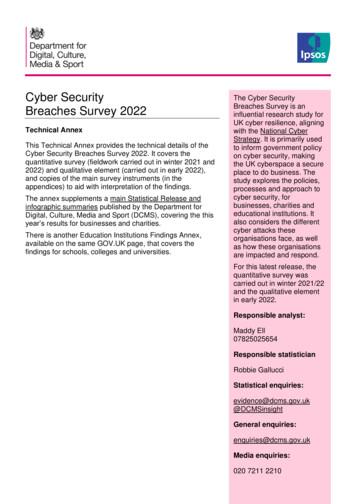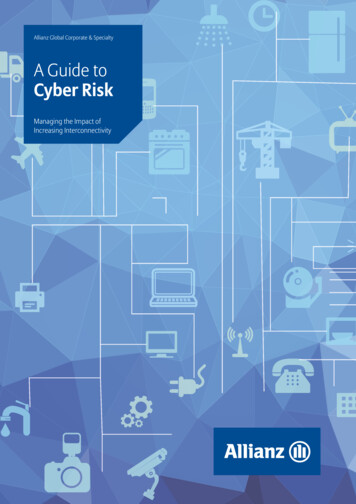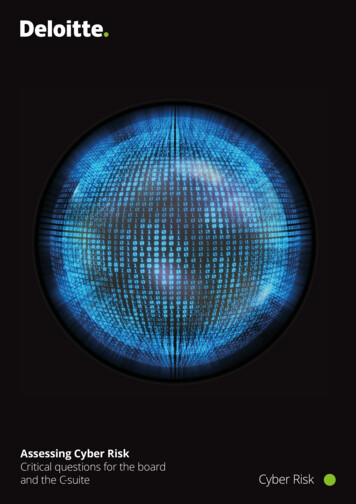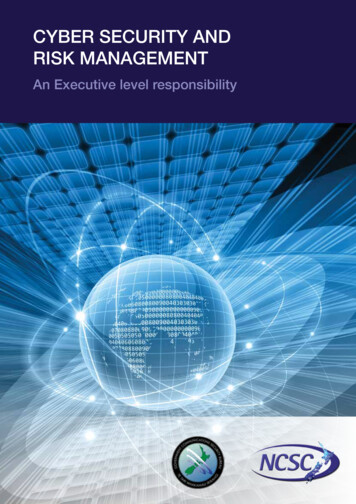
Transcription
CYBER SECURITY ANDRISK MANAGEMENTAn Executive level responsibility
Cyberspace poses risksas well as opportunitiesCyber security risks are a constantly evolving threat to an organisation’s ability toachieve its objectives and deliver its core functions.Security failings in today’s information-driven economy can result in significant longterm expense to the affected organisations and substantially damage consumertrust and brand reputation. Sensitive customer information, intellectual property,and even the control of key machinery are increasingly at risk from cyber attack.The targeting of electronic assets has the potential to make a material impact onthe entire organisation and possibly its partners.The topic of cyber security needs to move from being in the domain of the ITprofessional to that of the Executive and Board, where its consideration andmitigation can be commensurate with the risk posed. The traditional approach tothinking about cyber security in terms of building bigger walls (firewalls and antivirus software) - while still necessary - is no longer sufficient. A holistic approachto cyber security risk management – across the organisation, its network, supplychains and the larger ecosystem – is required.This document provides key questions to guide leadership discussions aboutcyber security risk management for your organisation. They are intended to benon-prescriptive, as organisational context will vary.This publication incorporates work originally researched, drafted and published by ourinternational partners (Australian Defence Signals Directorate, Her Majesty’s Government ofUK Crown Copyright, US-CERT). It has been reproduced with permission and any changeshave been made at the discretion of the NCSC. As this publication notes, even well-defendedorganisations may experience a cyber incident at some point. This publication cannot, and doesnot, offer any insurance against such incidents. Organisations are urged to seek professionaladvice in addressing the risks identified here. This publication is not intended to be a substitutefor that.ver 1: 20132
Protect your reputationEffective information systems are critical to the success of any organisation. Securemanagement of intellectual property and confidential or sensitive informationprovides competitive advantage and helps protect corporate reputation. This istrue whether that information is in the form of a product design, a manufacturingprocess, a negotiating strategy or sensitive personal data. At the same time, the needto access and share information more widely, using a broad range of connectingtechnologies, increases the risk of that information becoming compromised ormisappropriated.Compromise of information assets can damageorganisationsCompromise of information through, for example, staff error or the deliberateactions of an outsider could have a permanent or at least long-term impact on anorganisation. A single successful attack could have a devastating impact upon anorganisation’s financial standing or reputation. Information compromise can leadto material financial loss through loss of productivity, loss of intellectual property,reputational damage, recovery costs, investigation time, and regulatory and legalcosts. This in turn could lead to reduced competitive advantage, lower marketshare, lower profits, adverse media coverage, bankruptcy, or even - where safetycritical systems may be concerned - loss of life.Boards and Executives need an accurate picture of the information assets criticalto an organisation’s success. They also need to reassure themselves that theyhave up-to-date information on the known business security vulnerabilities andthreats so they can make informed information risk decisions.3
Many actors pose a risk to informationThere are many types of actors who pose a risk to business via IT informationassets: cyber criminals interested in making money through fraud or from the sale ofvaluable information industrial competitors and foreign state actors interested in gaining an economicadvantage for their own companies or countries hackers who find interfering with computer systems an enjoyable challenge hacktivists who wish to attack companies for political or ideological motives employees, or those who have legitimate access, either by accident or deliberatemisuse.The threat is not only technicalMany attempts to compromise information involve what is known as “socialengineering”, or the skilful manipulation of people and human nature. It is ofteneasier to trick someone into clicking on a malicious link in an email that they thinkis from a friend or colleague than it is to hack into a system, particularly if therecipient of the email is busy or distracted. There are also many well documentedcases of hackers persuading IT support staff to open up areas of a network orreset passwords, simply by masquerading as someone trusted.The key is effective organisation-wide risk managementand awarenessBeing aware of potential threats is a normal part of risk management acrossorganisations. Alongside financial, legal, HR and other business risks, companiesneed to consider what could threaten their critical information assets and whatthe impact would be if those assets were compromised in some way. The key ismitigating the majority of risks to critical information assets and being better ableto reduce the impact of, and recover from, problems as they arise.4
Put cyber security onthe agenda before itbecomes the agendaIncorporate cyber risks into existing risk managementand governance processesCyber security is NOT implementing a checklist of requirements; rather it ismanaging cyber risks to an acceptable level. Managing cyber security risk aspart of an organisation’s governance, risk management, and business continuityframeworks provides the strategic framework for managing cyber security riskthroughout the organisation.Elevate cyber risk management discussions to theExecutiveExecutive engagement in defining the risk strategy and levels of acceptablerisk enables more cost effective management of cyber risks that are alignedwith business needs. Regular communication between the CEO and those heldaccountable for managing cyber risks provides awareness of current risks affectingthe organisation and associated business impact.Implement industry standards and best practices,don’t rely on complianceA comprehensive cyber security programme leverages industry standards andbest practices to protect systems and detect potential problems. It is supported byprocesses informed of current threats and enables timely response and recovery.Compliance requirements help to establish a good cyber security baseline toaddress known vulnerabilities, but do not adequately address new and dynamicthreats, or counter sophisticated adversaries. Using a risk-based approach toapply cyber security standards and practices allows for more comprehensive andcost effective management of cyber risks than compliance activities alone.5
Evaluate and manage your organisation’s specificcyber risksIdentifying critical assets and associated impacts from cyber threats are key tounderstanding a company’s specific risk exposure– whether financial, competitive,reputational, or regulatory.Risk assessment results are a key input to identify and prioritise specific protectivemeasures, allocate resources, inform long-term investments, and develop policiesand strategies to manage cyber risks to an acceptable level.Provide oversight and reviewExecutives are responsible for managing and overseeing organisation riskmanagement. Cyber oversight activities include the regular evaluation of cybersecurity budgets, IT acquisition plans, IT outsourcing, cloud services, incidentreports, risk assessment results, and top-level policies.Develop and test incident response plans andproceduresEven a well-defended organisation will experience a cyber incident at some point.When network defences are penetrated, an organisation should have a clear ideaof how to respond. Documented cyber incident response plans that are exercisedregularly help to enable timely response and minimise impacts.Coordinate cyber incident response planning across the organisation. Earlyresponse actions can limit or even prevent possible damage. A key componentof cyber incident response preparation is planning in conjunction with the entireexecutive, business leaders, continuity planners, system operators, generalcounsel, and public affairs. This includes integrating cyber incident responsepolicies and procedures with existing disaster recovery and business continuityplans.Maintain situational awareness of cyber threatsSituational awareness of an organisation’s cyber risk environment involvestimely detection of cyber incidents along with an awareness of current threatsand vulnerabilities specific to the organisation and associated business impacts.Analysing, aggregating, and integrating risk data from various sources andparticipating in threat information sharing with partners helps organisations identifyand respond to incidents quickly and ensure protective efforts are commensuratewith risk.A network operations centre can provide real-time and trend data on cyber events.Business-line managers can help identify strategic risks, such as risks to the supplychain created through third party vendors or cyber interdependencies. SectorInformation-Sharing and Analysis Centres, government and intelligence agencies,academic institutions, and research firms also serve as valuable sources of threatand vulnerability information that can be used to enhance situational awareness.6
Ten steps to reduce yourcyber riskBasic information risk management has been shown to prevent up to 85% of thecyber attacks seen today, allowing organisations to concentrate on managing theimpact of the other 15%. Organisations should take steps to review, and investwhere necessary, to improve security in the following key areas:Information RiskManagementRegimeEstablish an effective governance structure and determine your riskappetite - just like you would for any other risk. Maintain the Board’sengagement with the cyber risk. Produce supporting information riskmanagement policies.Home and MobileWorkingDevelop a mobile working policy and train staff to adhere to it. Applythe secure baseline build to all devices. Protect data both in transitand at rest.User Education and Produce user security policies covering acceptable and secure useof the organisation’s systems. Establish a staff training programme.AwarenessMaintain user awareness of the cyber risks.IncidentManagementEstablish an incident response and disaster recovery capability.Produce and test incident management plans. Provide specialisttraining to the incident management team. Report criminal incidentsto law enforcement.Managing UserPrivilegesEstablish account management processes and limit the number ofprivileged accounts. Limit user privileges and monitor user activity.Control access to activity and audit logs.Removable MediaControlsProduce a policy to control all access to removable media. Limitmedia types and use. Scan all media for malware before importingon to corporate system.MonitoringEstablish a monitoring strategy and produce supporting policies.Continuously monitor all ICT systems and networks. Analyse logs forunusual activity that could indicate an attack.SecureConfigurationApply security patches and ensure that the secure configuration of allICT systems is maintained. Create a system inventory and define abaseline build for all ICT devices.Malware Protection Produce relevant policy and establish anti-malware defences thatare applicable and relevant to all business areas. Scan for malwareacross the organisation.Network SecurityProtect your networks against external and internal attack. Managethe network perimeter. Filter out unauthorised access and maliciouscontent. Monitor and test security controls.7
Next stepsIf you are uncertain about your organisation’s ability to manage its information risks,here are some practical steps that can be taken through corporate governancemechanisms:1. Confirm that you have identified your key information assets and the impact onyour business if they were to be compromised.2. Confirm that you have clearly identified the key threats to your informationassets and set an appetite for the associated risks.3. Confirm that you are appropriately managing the cyber risks to your informationand have the necessary security policies in place.Companies may not have all the expertise needed to implement some of thesesteps and assure themselves that the measures they have in place meet today’sthreats. Audit partners should be able to provide assistance in the first instance.For information risk management expertise, organisations should seek advice frommembers of appropriate professional bodies or those who have attained industryrecognised qualifications.About NCSCThe National Cyber Security Centre (NCSC) is responsible for safeguarding ournation’s government and critical infrastructure from cyber-borne threats that canaffect our national security, public safety, and economic prosperity.For more information, please visit: www.ncsc.govt.nzTo report a cyber incident: www.ncsc.govt.nz/incidents or 64 4 498 7654
Cyber security is NOT implementing a checklist of requirements; rather it is managing cyber risks to an acceptable level. Managing cyber security risk as part of an organisation's governance, risk management, and business continuity frameworks provides the strategic framework for managing cyber security risk throughout the organisation.


